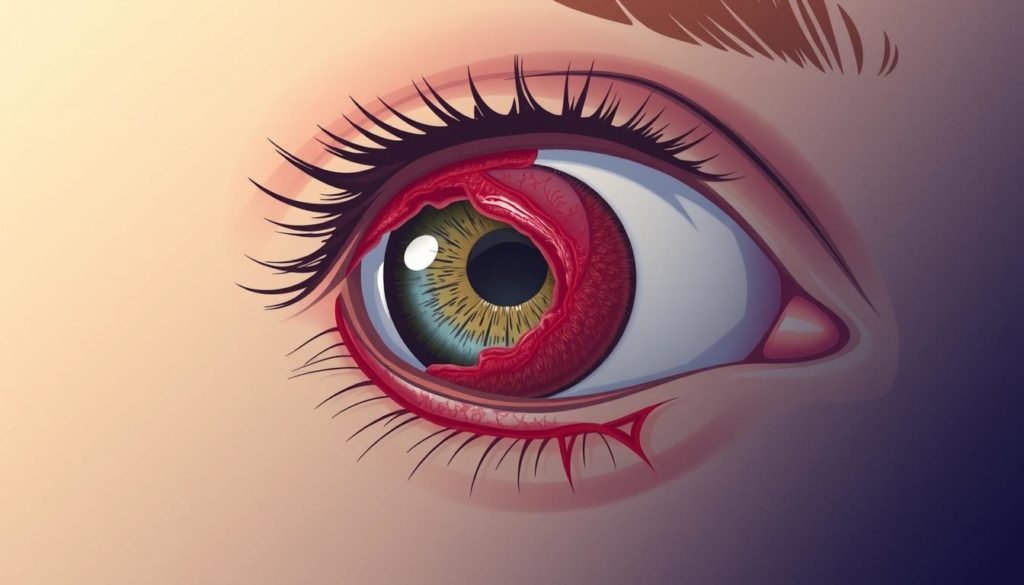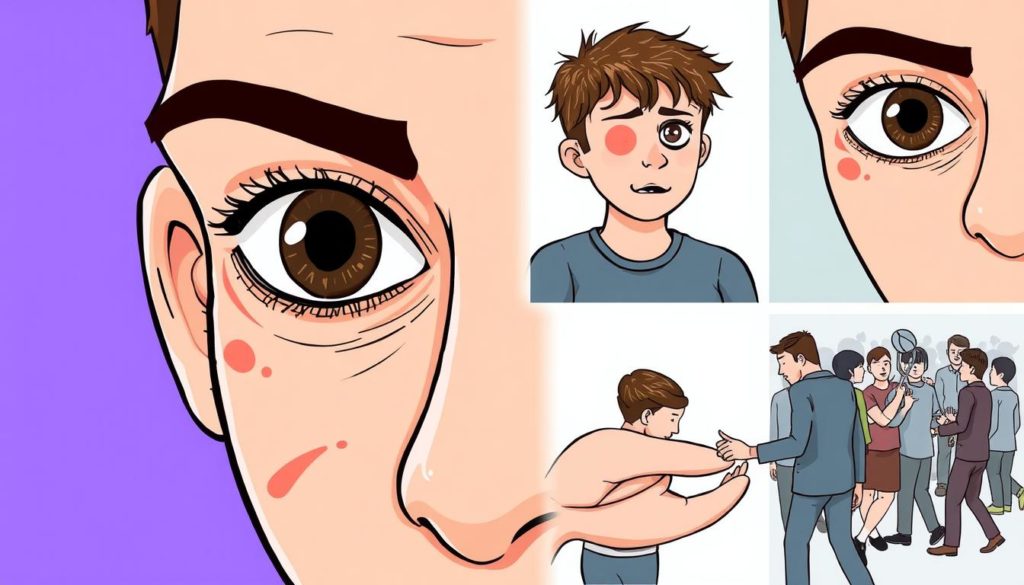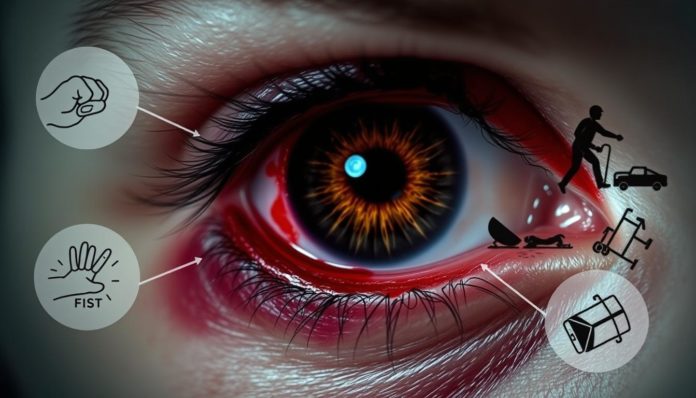About 85% of black eye injuries come from accidents or sports. Most black eyes look scary but are minor and heal by themselves. Yet, knowing what causes them, spotting the symptoms, and when to see a doctor is important. This knowledge helps you deal with black eyes better.
We will cover what leads to a black eye, how to care for it, and treatment choices. We’ll highlight when it’s crucial to get medical help. This way, you’re ready to deal with a black eye if it happens.
A black eye can happen from sports, surgery, or a simple fall. Knowing how to manage it speeds up recovery, reduces discomfort, and prevents more issues. Let’s start learning how to care for a black eye correctly!
What is a Black Eye?
A black eye is known in medical terms as a periorbital hematoma. It’s when dark bruising appears around the eye. This occurs after small blood vessels break, causing blood to collect under the skin. This leads to the visible dark color.

Definition and Basic Explanation
The injury usually impacts the area around the eye, not the eye itself. The bruising can look blue or dark purple. It often gets worse before it starts to get better. Swelling is common, sometimes making it hard to fully open the eye.
Common Terminology: “Shiner” and “Periorbital Hematoma”
In everyday talk, people often call a black eye a shiner. This slang term refers to the dark discoloration and swelling that you can see. On the other hand, periorbital hematoma is the medical term. It describes blood gathering beneath the skin near the eye socket more scientifically.
| Term | Definition | Common Usage |
|---|---|---|
| Shiner | Dark bruising and swelling around the eye | Casual conversation |
| Periorbital Hematoma | Blood accumulation around the eye socket | Medical context |
Causes of a Black Eye
Knowing why black eyes happen is important for stopping and treating them. Black eyes, with bruising around them, come from things like hits to the face, surgery issues, and getting hurt while playing sports.
Blows to the Face
Getting hit in the face is a big reason for black eyes. This happens in fights, when people run into things or get hit by balls, and when they fall. These hits make blood vessels under the skin break. This causes the black eye.
Cosmetic and Dental Surgeries
Some surgeries, for looks or dental work, can cause black eyes too. Things like putting in face implants or taking out wisdom teeth mess with face tissues. This can lead to bruises and color changes around the eyes. We call these issues from beauty surgeries and teeth surgeries.
Accidents and Sports Injuries
Accidents cause many black eyes. Especially in sports like boxing, martial arts, or football. The hard action in these sports leads to more face injuries and, often, black eyes.

Each thing that causes a black eye, like hits, surgery issues, or sports hurts, does so in its own way. Below, we highlight the main points of each source:
| Cause | Description | Examples |
|---|---|---|
| Blows to the Face | Direct impacts causing facial trauma | Fistfights, accidental collisions |
| Cosmetic Surgeries | Procedures leading to facial bruising | Facial implants, eyelid surgery |
| Dental Surgeries | Dental procedures causing tissue disturbance | Wisdom tooth extraction, jaw surgery |
| Sports Injuries | Injuries from contact sports | Boxing, martial arts, football |
Symptoms of a Black Eye
Black eye symptoms often include a discolored and swollen area. Recognizing these signs is key to understand their severity. This knowledge helps decide on the correct treatment path.
Discoloration and Swelling
Significant discoloration is a common symptom of a black eye. The bruising can be deep blue or purple at first. Then, it changes to green and yellow as the healing goes on.
Swelling is also typical and may limit how much you can open your eye. This issue brings pain and tenderness, increasing the discomfort.
Temporary Blurred Vision
Temporary blurred vision is another symptom. It occurs when fluid builds up around the eye tissues. This condition affects clear seeing but usually gets better on its own.
Even so, it’s important not to ignore it. Blurred vision can disrupt daily life and lessen your overall well-being.
Pain and Discomfort
A black eye can cause facial pain, from mild to sharp. This pain comes from the injury to facial tissues. Swelling and tenderness can make the pain worse.
It’s crucial to treat this pain right. The right care makes managing the discomfort easier.
How a Black Eye is Diagnosed
Knowing how a black eye diagnosis works is important for proper care. Doctors use physical examinations, imaging tests, and vision assessments to understand the injury’s seriousness.
Physical Examination
In a physical examination, doctors check the face carefully for trauma signs. They look for swelling and discoloration to gauge the injury’s extent. This is the first step in evaluating the damage.
Imaging Tests: X-Rays and CT Scans
For serious injuries, imaging tests like X-rays and CT scans might be needed. They find fractures or internal injuries not seen in a physical check.
Vision and Eye Movement Tests
Assessing vision and eye movement is key to understand how the injury affects sight. These tests reveal any injury-related complications, guiding specialists in treatment choices.
Treatment for Black Eye
Treating a black eye often starts with simple self-care at home. Using home remedies can help a lot and speed up healing. For more serious cases, it’s vital to see a doctor to avoid complications.
Home Remedies
To deal with a black eye, some home treatments work well. First, use ice packs for the first 24-48 hours to keep swelling down. After swelling goes down, use warm compresses to help healing. Taking over-the-counter pain relievers like ibuprofen can also ease pain. Doing these things can help you recover faster.
Medical Interventions
Sometimes, you might need medical help for a black eye. Signs that you need a doctor include lasting vision problems, more pain, or if you see redness and pus. Doctors might give you special meds or do tests like X-rays. These checks make sure there’s no serious injury.
Learn more about when to get medical help for black eye symptoms.
Avoiding Common Myths: Raw Meat
Lots of myths exist about treating black eyes. A common one is using raw meat. However, putting raw meat on a black eye can actually cause infections. It’s best to use known remedies and medical advice for safe healing.
How to Get Rid of a Black Eye Faster
Having a black eye can be painful and embarrassing. But, learning how to heal a black eye quickly involves some simple methods. These can speed up healing and ease your pain.
Using Cold and Warm Compresses
Right after getting hurt, use a cold compress. It helps cut down swelling and lessen the bruising. You should apply the cold pack to the injured spot for 15-20 mins every hour. Do this for the first 24-48 hours.
After those first two days, start using warm compresses. Warmth improves blood circulation and helps remove the pooled blood. This helps your eye heal quicker.
Over-the-Counter Pain Relievers
To help with pain and swelling, try drugs like acetaminophen or ibuprofen. They ease the discomfort and reduce the swelling around your eye. These drugs are very effective.
Preventive Measures
To avoid getting black eyes in the future, prevention is crucial. Wear safety glasses during sports and make sure your home is safe. Fixing loose rugs and keeping things tidy greatly cuts down injury risks. Taking these steps can keep you safer during daily tasks and fun.
| Method | Purpose | Application Time |
|---|---|---|
| Cold Compress | Reduce swelling and initial bruising | First 48 hours, 15-20 minutes every hour |
| Warm Compress | Promote blood flow and healing | After 48 hours, several times daily |
| Pain Relievers | Manage pain and inflammation | As directed on medication label |
Utilizing these methods can help manage a black eye well. They encourage faster healing and reduce discomfort. Knowing these tips for quicker recovery can also lower the chance of any complications.
Black Eye Explanation
An in-depth black eye explanation digs into what happens beneath the skin around our eyes. Force to this area breaks blood vessels under the skin. This leads to the discoloration and swelling we see. The understanding black eye effects helps us know why these injuries turn purple, blue, and black over time.
A black eye isn’t always from getting hit directly in the eye. It can come from hitting your forehead, nose, or cheek too. Blood then pools around the eye because of gravity. A comprehensive black eye insight also sees that the bruise fades as the body heals itself and absorbs the blood back.
Be careful with complications like increased pressure around the eye or changes in vision. A black eye is more than just a bruise. Understanding black eye effects means knowing it may signal deeper injuries. Always get a doctor’s help if things get worse or new symptoms show up.
Risks Associated with Black Eyes
A black eye usually heals by itself, but it’s key to know the risks beyond just bruising and swelling. It’s critical to determine if the injury signals something more severe. Understanding these risks helps assess the situation better.
Potential for More Serious Injuries
Black eyes might hide more severe injuries. These include skull fractures, eye socket breaks, or damage to the eye. All these situations need quick medical help. Symptoms like ongoing headaches, a lot of pain in the face, or seeing double are warnings. If you notice these signs, get them checked out right away to avoid serious harm.
Signs When to Seek Emergency Care
Knowing when eye trauma needs urgent care is vital. Seek immediate help for symptoms like ongoing sickness, changes in sight, or signs of a concussion, such as feeling dizzy or blacking out. These could mean the injury is more than just a bruise. Getting help quickly is key to preventing worse problems. Always see a doctor if you have these symptoms, to tackle any dangers early.
FAQ
What are the main causes of a black eye?
A black eye usually comes from a hit to the face. This can be due to fighting, sports accidents, bumping into hard things, or surgeries like facelifts or removing wisdom teeth.
How long does it usually take for a black eye to heal?
Black eyes typically heal on their own in 1-2 weeks. The color and swelling slowly get better during this time.
What are the primary symptoms of a black eye?
Signs of a black eye include a lot of bruising, swelling that can stop you from opening your eye completely, pain, and sometimes blurred vision. Blurred vision can happen when fluid builds up around the eye.
How is a black eye diagnosed?
A doctor will look at the injury and test your vision and eye movements. They might also do X-rays or CT scans. These tests check for broken bones or deeper injuries if the black eye is really bad.
Can home remedies help treat a black eye?
Yes, home treatments can help. Using ice for the first 48 hours reduces swelling. Warm compresses help after that. Taking medicine from a store can lessen pain. But don’t use raw meat on a black eye. It can cause an infection.
Are there any myths about treating black eyes that I should be aware of?
One myth is using raw meat on a black eye helps it heal. This isn’t true and can lead to infection. Use ice and warm compresses instead.
How can I get rid of a black eye faster?
There’s no quick way to heal a black eye. But cold packs right away and then warm compresses can aid. Pain relievers from the store and using protective glasses in sports also help.
What are the risks associated with black eyes?
Black eyes are usually minor. However, they can point to bigger issues like skull fractures or eye injuries. If you keep getting headaches, your vision changes, or you show concussion signs, see a doctor fast.
When should I seek emergency medical care for a black eye?
Get emergency help if headaches last, vision goes or doubles, you throw up, or have symptoms that suggest a severe injury or concussion.


